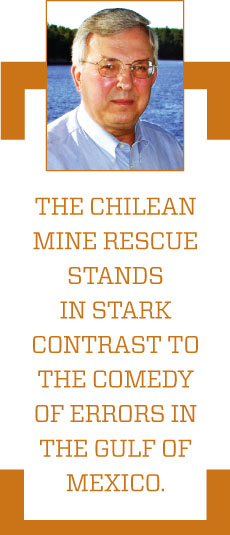Engineering Trumps Science
Design details and urgent problem-solving, not study, save the day.
The day after 33 Chilean miners were brought safely to the surface after being trapped underground for 70 days, a newspaper story carried the headline: “Chile’s Rescue Formula: ‘75% Science, 25% Miracle.’ ” But the headline misquoted the topographer who had directed the drilling that located the miners. What she actually had said was even quoted in the body of the article: “It was 75 percent engineering and 25 percent miracle.” Did the headline writer see science where engineering was clearly said and meant? Did the headline writer really believe that science and engineering are equivalent?
Engineering is not a synonym for science; it is more than science. Had science alone been relied upon to rescue the miners, they might still be there. Science is about studying what is; engineering is about doing something about things as we find them. Engineers may exploit scientific knowledge in seeking solutions to problems, but engineering is about going beyond science into the realm of design.
It was the prior design of a novel drill bit that enabled a rescue shaft to be driven through 2,000 feet of solid rock in less than half the time originally estimated by Chilean officials. The bit had been engineered by a small Pennsylvania company called Center Rock. What distinguished it from conventional drill bits was that it incorporated hammers that crushed the pieces of loose rock that were produced by the drilling.
But engineering is more than just employing clever pieces of machinery. It is also about devising schemes and systems that enable the machines to be used wisely and efficiently in the context of the problem at hand. In Chile, the damaged mine was located in a desert area where the volcanic rock contained no water. Had water been present, the liquid would have absorbed the hammers’ energy, thereby slowing down progress on crushing the stone.
But the crushed rock still had to be removed from the shaft. This might normally have been done by introducing drilling mud, which would have carried the loosened material up to the surface for disposal. In the Chilean mine rescue, the crushed rock pieces were allowed to drop through the small bore hole that had been drilled first to locate the miners and then used as a pilot hole to guide the Center Rock drill bit. Collectively, all of these engineering design decisions — not science — enabled the rescue shaft to be advanced at record speed.
Even before the shaft was completed, rescuers knew they had to solve another engineering problem: how to bring the miners safely up to the surface. International teams, whose players ranged from Chilean naval engineers to NASA aerospace engineers, contributed to the design of a rescue capsule that would move smoothly down and up the shaft without binding. And they did so, again with the speed of urgent engineering problem-solving rather than the more casual pace of scientific studying.
The Chilean mine rescue was a triumphant engineering achievement. It was in stark contrast to the comedy of errors that accompanied efforts earlier in the year to stanch the flow of oil into the Gulf of Mexico. Those efforts, which were subject to the often politically motivated oversight, review, and veto by scientists ranging from regulatory environmentalists to a Nobel-laureate physicist, did not let the engineers freely do their creative thing. Had they been allowed to do so, the oil that gushed from the failed blowout preventer might have been stopped sooner than it was. But then, would the newspaper headlines have credited engineering or science with the accomplishment?
Henry Petroski is the Aleksandar S. Vesic Professor of Civil Engineering and a professor of history at Duke University. He is the author of, among other books, The Essential Engineer: Why Science Alone Will Not Solve Our Global Problems.
Category: Refractions
